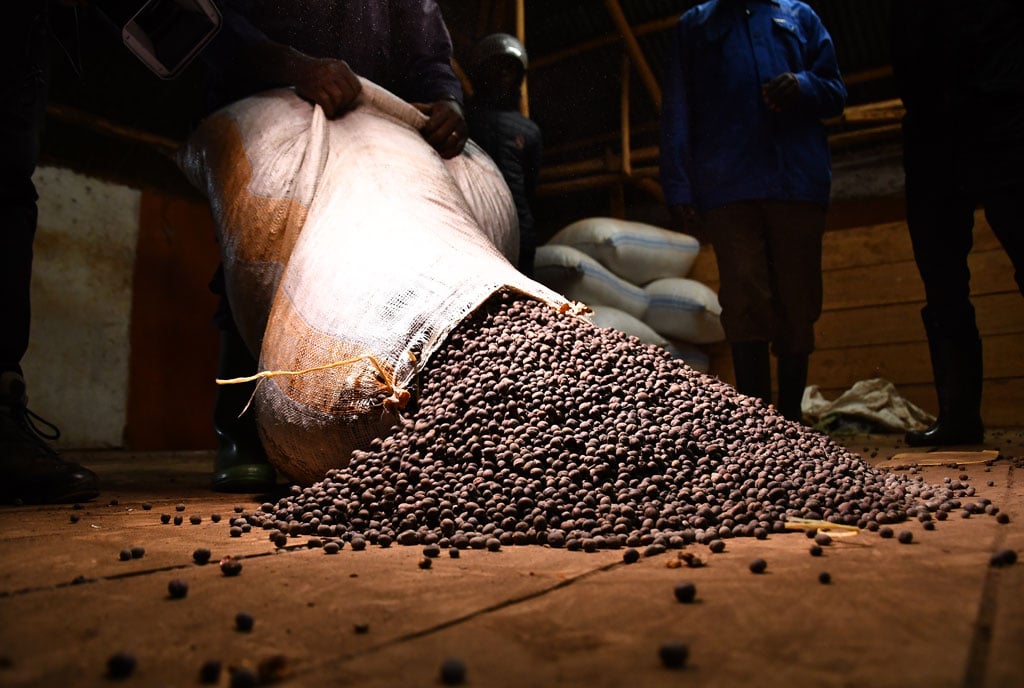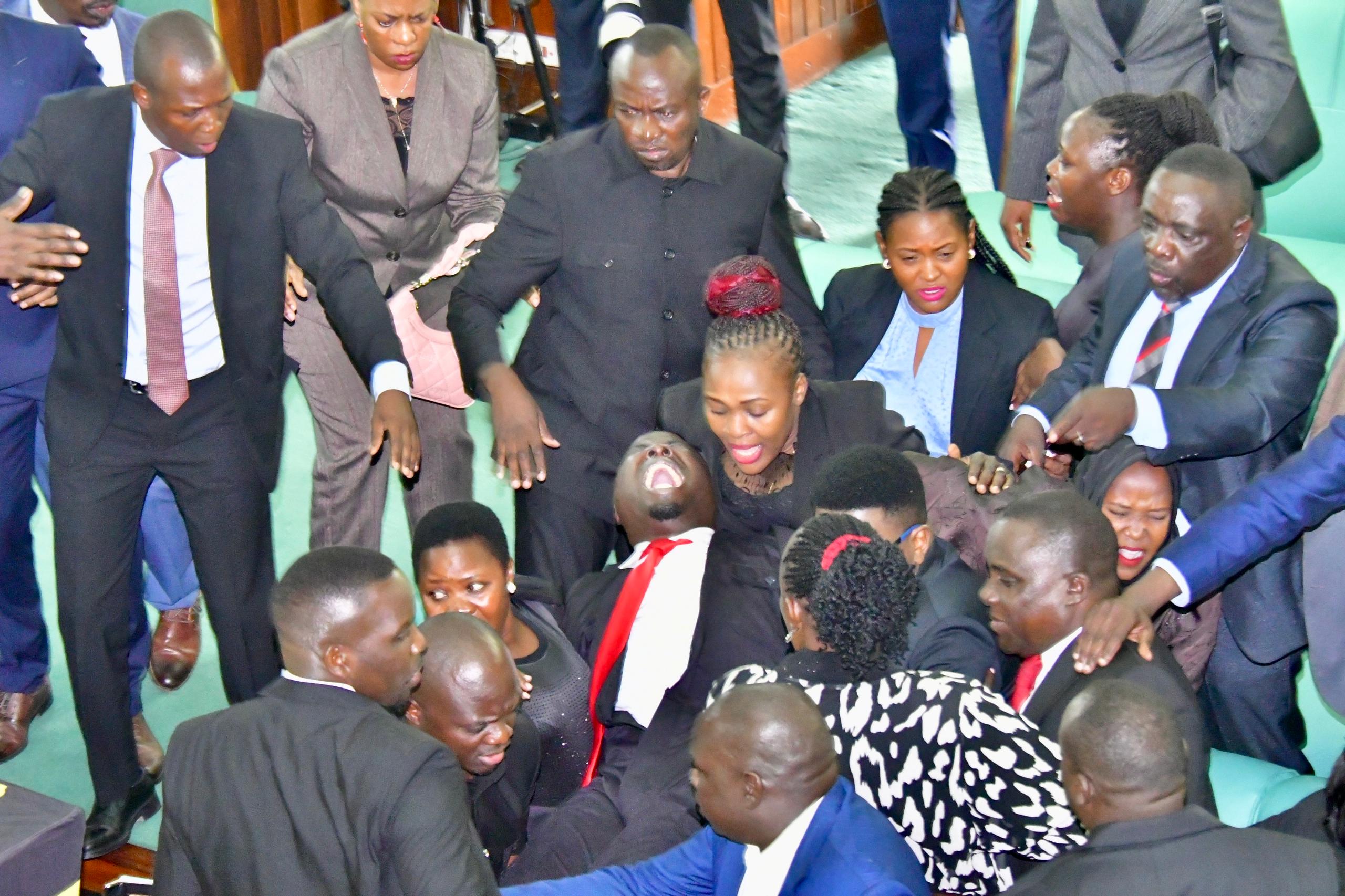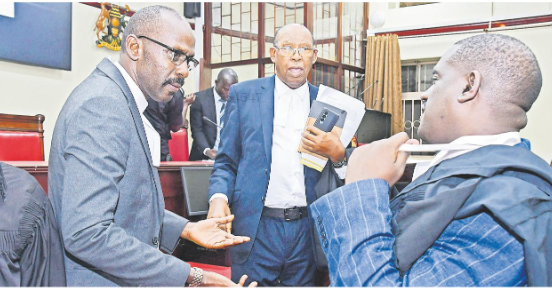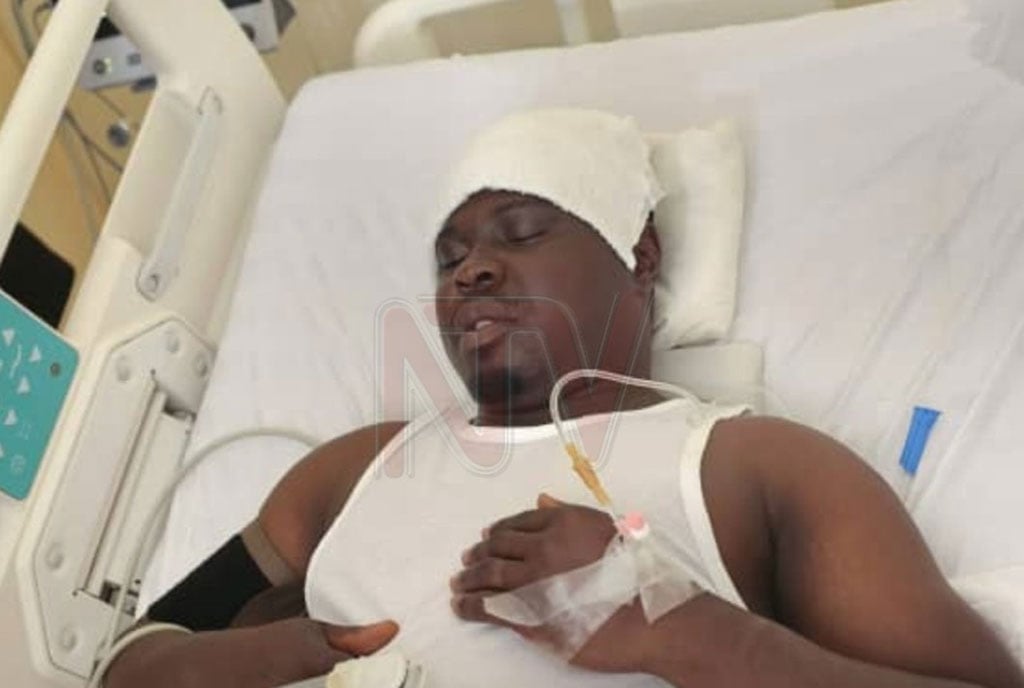
Justice Isaac Muwata during the hearing of the late businessman Henry Katanga case at the High Court in Kampala on August 27, 2024. PHOTO | ABUBAKER LUBOWA
At 10:10am, judge walks to the court room. Court clerk calls for the Henry Katanga murder case file
Prosecutor Samali Wakooli: May it please you my Lord, my name is Wakooli Samali, Assistant DPP. I represent the state together with Jonathan Muwaganya and Anna Kiiza. We have Ayebazibwe Edgar on watching brief. The accused persons are represented by Mr Peter Kabatsi, counsel Macdosman Kabega, Bruce Musigunzi, Elison Karuhanga, Khanat Nabagala and Zulaika Kasajja.
My Lord this matter is coming up for further hearing and we are ready to proceed
Judge: How many do you have today?
Wakooli: We have two but let’s see how we proceed if we can have all.
Judge: Let’s proceed, this is PW what?
Wakooli: PW8
Judge: What religion, you know we have many Christian sects.
Witness: Anglican.
Witness takes oath
Wakooli: For the record, repeat to this court your particulars.
Witness: My Lord, my name is Andrew Kizimula Mubiru
Defence counsel Peter Kabatsi: My Lord, unfortunately, we don’t have his statement
Wakooli: My Lord, he is an expert witness and we did disclose to them all the statements over three months ago.
My Lord, I don’t know what my senior ate and drank but we disclosed everything to them.
Kabatsi: We don’t know whether he is an expert, we know nothing about him. We can adjourn and collect a statement from him as we take on another witness.
Wakooli: We disclosed to them over three or four months ago. I don’t know what my senior here ate or drank because we did disclose and we have disclosure forms on court file.
Kabatsi: My Lord, I think it’s very simple, let’s have another witness as this one records.
Wakooli: My Lord, we are the prosecutors in this case and we determine which witness we bring and when and we are not supposed to bring a witness as to when they wish. We have already provided everything that they need and prepared for. Infact, even Mr Kabega is looking at a copy of the said statement.
Judge: Let’s proceed.
Defence lawyer Kabega: My Lord, I’m sorry, what we do have is not the one.
Judge: How do you reconcile, but let’s proceed

Wife of the late businessman Henry Katanga, Molly Katanga appears virtually.
Wakooli: How old are you?
Withess: My Lord, I’m 44 years old.
Wakooli: Where do you stay?
Witness: I reside in Bweyogerere.
Wakooli: What do you do for a living?
Witness: My Lord, I’m a forensic scientist employed by the Government of Uganda.
Wakooli: In what capacity are you employed in the government?
Witness: I’m at the rank of Assistant Commissioner of Police. I also have an acting role of director of forensic services.
Wakooli: As director, what are your key roles?
Witness: My Lord, my roles are mainly administrative and as acting director, my main role is to superintend forensic services. I supervise personnel but also capable of creating analysis.
Wakooli: As a forensic examiner, what are your key roles?
Witness: As a forensic examiner, my Lord, my role is to undertake forensic examination of evidential material that has been submitted.
Wakooli: How long have you been a forensic examiner?
Witness: This is my 21st year.
Wakooli: Mr Mubiru, would you tell us what your qualifications are
Witness: My Lord, I hold a Bachelor of Science Degree of Industrial Chemistry from Makerere University in 2003, I also hold a Master’s in Forensic Science from King’s College London (2008). I’m a roaster member for the Justice Rapid Response based in the Hague. My Lord, I’m an affiliate member of the Chartered Society of Forensic Sciences. My Lord, I’m also a certified senior leader assessor under ISO 17205. My Lord, this is a global standard published in 2017.
Wakooli: Earlier, you told us that you are an examiner, how do you receive requests?
Witness: My Lord, requests are received on police form 17A, detailing the evidential material and a request for analysis.
Wakooli: If I showed you this police form 17A, can you identify them?.
Witness: I have duplicates of it.
Judge: Where is the original?
Witness: It’s on the laboratory file. It’s dated November 3, undersigned laboratory number DFS/ DNA/ 682/ 23.
Wakooli: What was in that request?
Witness: It had a number of exhibits
Defence lawyer Kabega: I don’t have a copy of that request.
Judge: Do your colleagues from KAA have it?
Defence lawyer Kabatsi: We do.
Judge: Can you share in the meantime as we continue?
Wakooli: The last question to you was what was that request for ?
Witness: Requests and exhibits with three examinations required.
The first exhibition was marked D-1, my Lord, this is a blood swap from the deceased, Henry Katanga, recovered during the postmortem. The second exhibit was marked D-2, a blood swap from the deceased also recovered during the postmortem . The next exhibit was marked KH1 which is a blood swap from the deceased from the crime scene, then the next one KH2, blood swap from the deceased recovered from the crime scene. The next one my Lord, is exhibit marked M-1, the description is left hand swab from Molly Katanga recovered from hospital.
The other was exhibit marked M-2, a right hand swab from Molly Katanga .
Exhibit marked M-3, that is the right hand swab from Molly Katanga recovered from hospital, exhibit marked M-4, this is a mouth swab from Molly Katanga recovered while at the hospital, exhibit marked H, was described as hair strands from the washroom door frame.
Karuhanga: My Lord, I’m sorry to interrupt, we don’t have that exhibit marked H.
Judge: So what do we do?
Karuhanga: It’s not a photocopy issue.
Wakooli: My Lord, it’s the first page which is missing and we can undertake to photocopy.
Karuhanga: The evidence is incomplete, his own name doesn’t appear in the report, he needs to supply us with everything.
Kabega: Let him give us his originals on the file from where he is reading.
Court adjourns for 30 minutes to allow the photocopying of the missing documents. Court resumes at 11:47am
Next is exhibit marked D-7, a pair of shorts, recovered from the body of Henry Katanga. Next is exhibit marked D-8, a pair of shorts describe as a yellow, light blue, black, pink, green striped pair of shorts.
Next is exhibit marked D-9, white bed sheets and suspected blood stains recovered from the deceased in the master bedroom at the crime scene.
Next is D-10, a suspected blood stained badge on gauze, recovered from the deceased during postmortem. Next is exhibit marked 4, which is a black Zasetava, Arms pistol serial number UG1622200061, CZ99.
Judge: Who added on?
Witness: I can see, it’s written here.
Exhibit marked 9, this is a blood swab from the bathroom of the master bedroom at the crime scene. Exhibit marked 14, marked as a blood swab, from the door handle of the bedroom opposite the master bedroom at crime scene. Next is exhibit marked 15, described as a blood swab, from the toilet inside the bedroom opposite the master bedroom of the crime scene.
Next is exhibit marked 16, which is a blood swab from the wall to the changings and bathrooms inside the master bedroom. Next is exhibit marked 17, this is a blood swab from the door frame, inside the changing and bathroom of the crime scene. Next is exhibit marked 17-1, this is described as blood scrapping from the door frame of the washroom at the crime scene.
Next my Lord is M-5, described as a white dress with decorated yellow, black and red flowers allover, recovered from Molly Katanga at the hospital.
My Lord, next is exhibit marked M-6, described as a light gray bed sheets with printed works, IHK Radiology, recovered from Molly Katanga at the hospital. Next my Lord is exhibit marked M-7, described as pink bedcover, with white stripes running horizontally with wording; Bugolobi Medical Center recovered from Molly Katanga at the hospital. Finally, exhibit D-6, described as pink with white green brown, light blue stripped bedcover, having suspected blood stains recovered while found used to cover Katanga body at the crime scene inside the master bedroom.
My Lord, these are the exhibits we received on November 3, 2023.
Wakooli: What was the request for?
Witness: My Lord, the request was to examine all the above for DNA traces and ascertain whether the DNA traces on exhibits marked 4 matches with traces on exhibits marked M-1, M-4, K,9, 14, 15, 16, and 17.
The next request was if yes, who is the main donor of the traces on exhibit marked 4. Then the 3rd question was, compare the DNA on the exhibits with the DNA traces marked D-1, M-4, K and ND. Request four is to carry out any relevant forensic examination that can assist in the investigations.
Wakooli: Hands the witness some documents.
Witness: This is a set received on November 6, 2023. The first exhibit is marked folder three, this is a swab from the trigger of the pistol UG1622200061, CZ99 compact. Second is exhibit marked 22-1, its described as blood swab from the door curtains from the balcony of the master bedroom.
Next is exhibit marked 19, this is a wooden baton, with brown leather sling, recovered from the side drawer of the master bed. Next is exhibit marked N-D, this is describe as a swab from the mouth of Ayebare Denise. Next is exhibit marked 20, described as a multi-coloured towel, recovered from the shower room of the master bedroom. Next is exhibit marked 21, described as a moping rag, attached on a wooden handle, recovered from the washroom. Another exhibit was marked D-3, D-4, described as swabs recovered during the postmortem. Next is exhibit marked 5-1, described as, one projectile recovered from the bed of the deceased at the crime scene.
Next is exhibit marked 4-2, described as live ammunition found in bullet chamber. Next is exhibit marked 5, a one suspected pistol live ammunition recovered on the deceased’s bed. Next was exhibit marked 7, is described as cartridge casing recovered on the bed sheet at the crime scene. Then we have exhibit marked 4-1, described as a postal magazine with 10 live ammunition removed from the pistol. My Lord these were e exhibits we received on November 6.
Wakooli: What was the request?
Witness: My Lord, this was to examine and ascertain whether there is DNA on exhibits submitted. Next was to compare the DNA on exhibits with DNA on D-1, D-2, M-4, K and ND.
The final one was to carry out any analysis that may help in the investigations.
Wakooli: When did you receive these exhibits?
Witness: My Lord, we received them on November 9, 2023.
Wakooli: What were they?
Witness: It is an exhibit marked 2, described as a swab obtained on the floor, near the eastern door to the master bedroom. The next set of exhibits was marked A-F, describe as suspected blood swabs from the western wall of the wardrobe in the master bedroom near the door leading to the washroom. Next were exhibits marked G and H, these are swabs obtained from the part of the wall between southern master bedroom door and the washroom door. Next were the exhibits obtained from the Western part.
Next is exhibit marked I and J. These were swabs obtained from the western part of the of frame the master bedroom southern door.
Next is exhibit marked P. This was a swab obtained from the southern wall from the master bedroom near the southern door. Next is exhibit marked Q. This was described as swab obtained on top of the drawer on the southern wall near the southern door of the master bedroom.
Next is exhibit marked A-A, described as a handle of a glass water jar on the master bedroom side drawer.
Next is exhibit marked A-B, this was from the outer surface of the glass cup on the master bed side drawer. Next is exhibit marked A-C, this was marked as suspected brain matter from the net (mosquito net). My Lord these are the exhibits we reviewed on November 9, 2023.
Wakooli hands the witness another request form.
Wakooli: What was the request for?
Witness: My Lord, the request was to examination and ascertain whether there was DNA on exhibits submitted. Next was to compare the DNA on exhibits with the DNA on D-1,D-2, M4, K, and ND. The next was to carry out any analysis that may help in the investigations.
Wakooli hands the witness another request.
Witness: My Lord, this is a police form 17, with a set of exhibits received on November 10, 2023.
Wakooli: What exhibits did you receive on the 10th
Witness: My Lord, the first exhibit was marked CI-1, it was a swab of suspect blood stains from the concrete ceiling near the light bulb at the scene of crime. Next one was marked CI-2, this was described as a swab of suspected blood stain from the concrete ceiling from the southern wing.
Next is exhibit marked MB, this was described as a swab of suspected blood stains on the leg side of the bed frame (outer surface). Next is exhibit marked 24-1, this was described as a T-shaped copper-like, adjustable walking stick recovered from the south Eastern corned of the scene of crime.
My Lord, finally, we have exhibit marked, 24-2, 24-3, described as 160 centimetre wooden sticks recovered from the south eastern corner of the seat of crime.
Wakooli hands the witness another request
Wakoooli: What was the request?
Witness: The request my Lord, was to examine and ascertain whether there is DNA on exhibits submitted. Next was to compare the DNA on exhibits with DNA on D-1,D-2,M-4, K, and ND. The other was to carry out any analysis that may help in the investigations.
Wakooli hands the witness another police form 17A.
Witness: This is a police form 17A, with a set of exhibits, received on November 21, 2023.
The first exhibit is marked 10-1, its described as multi-coloured free dress (kitenge), recovered on top of the bed in the bedroom opposite master bedroom. Next is exhibit marked KP, described as maroon dress with yellow and white decoration, recovered from Kakwanza Patricia.
Wakooli hands the witness another police form request.
Witness: This request was to examine and ascertain whether there was DNA on the exhibits submitted. Next was to compare the DNA on exhibits K, C and ND. And finally, carry out any analysis that may help in the investigation.
Wakooli hands the witness another police form 17A.
Witness: This was received on November 23, 2023 with a set of exhibits. The first exhibit was marked J-3, described as a blood swab on the northern wall near the master bed. Next was exhibit marked M, described as a blood swab on the lower part of the wardrobe on the eastern wall of the master bedroom.
Next was exhibit marked R, this is described as a blood swab from the southern wall near south eastern corner of the master bedroom. Next is exhibit masked T, this is described as a blood swab from the western wall of the master bedroom. Finally, we have exhibit marked Z, this is a blood swab from the floor near the master bedroom.
Wakooli hands another police request
Witness: To ascertain whether the DNA in exhibits J3, M, R, T and Z matches with the control samples earlier on submitted.
Wakooli: After receiving all these exhibits, what happened?
Witness: They are transmitted into a laboratory after a case examiner has been assigned.
Wakooli: How is a case assigned?
Witness: It’s assigned by the head of department
Wakooli: Which department are we talking about?
Witness: Chemical, biological, radiological nuclear, explosives analysis.
Wakooli: Take us through the steps you take once a case has been assigned to you.
Witness: As an examiner, I have a team. I’m the lead examiner, supervisor and reviewer. I also have an analysis and technician. My team and I have access these exhibits from the forensic gateway, and they are accompanied by police form 17A and a chain of customer log.
Wakooli: What happens next?
Witness: Upon receipt of the evidence material, we proceed to examine the evidence, one exhibit at a time, taking note of our observations in light of the instructions given on police form 17A and keeping the examination request.
The examination of the evidential material is not a single day’s task. So within the laboratory space, we have temporary storage where we can access the exhibits during the course of examination because this examination takes several steps.
Wakooli: Take us through the steps that you undertook.
Witness: We first under take a visual examination during this stage , we take still photographs of the evidence, we observe for visible stains, if the stains are suspected to be either blood or saliva, we also do a presumptive test.
We also take the opportunity to sketch out this area as we also identify where we have observed this stain and we get a specimen which is a characteristic of the case number. For the items where we don’t have visible stains, we take swabs of areas where we believe human contact may have occurred. The swabs are also given unique numbers. Once we are done with this stage, we proceed to extract genonomic DNA. This is the DNA we are interested in from other exhibits.
The next stage is to quantify the amount of DNA that we have extracted. This stage is called quantification. The purpose of quantifying the DNA is whether we have inhibition, which means our extraction failed. If the quantification fails, we have to repeat.
Wakooli: In this particular case, what report did you make?
Witness: Because of the volume of the evidential material and many requests coming in each other’s day, we were able to offer investigative report.
This investigative report was issued as we continued with the examination. By and large, its preliminary in nature and its purpose is to guide investigation. Once, we were ascertained that they were normal requests received, we were obliged to issue an evaluative report for court purposes.
Wakooli: If showed that report, would you be able to identify it?
Witness: The forensic reports are released by the director, forensic services and bare a date of the release of the report. The date when the examiners concluded that report. There are hash numbers of the examiners and their signature and those are the identifying. The hash numbers are for safety and integrity of the examiners.
Wakooli: In this particular case, what was your hash number?
Witness: Hash 01
Wakooli hands the witness the report.
Witness: This is a report by Vide Jinja Road CRB 1700/ 23, it was released under reference DFS/DNA682/ 2023 released on April 30, 2024 to OC CID Jinja Road and the releasing officer was Chelagant Sylvia, the acting director, Forensic Services.
I can confirm that this is the original report authored by me and my team released on April 30, 2024.
Wakooli: You will take us briefly about the contents of this report.
The witness will continue with his testimony in chief this morning.








